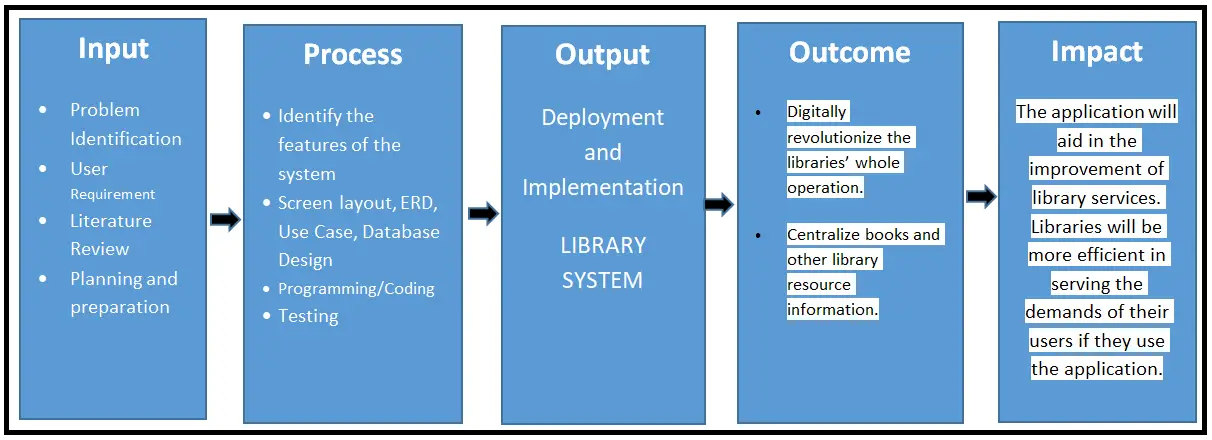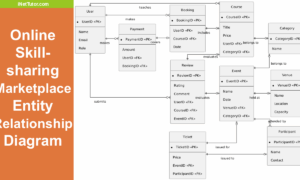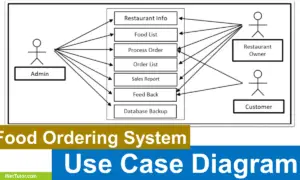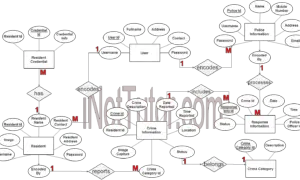Library System Conceptual Framework
This article will show you how to create a conceptual framework for the capstone project titled Library System. The input, process, output (IPO) model was used to create the conceptual foundation for this investigation.
About the Project
Table of Contents
Libraries serve as one source of knowledge that provides numerous resources such as books, articles, journals, and many more. A librarian is a person in charge of a library, who is in charge of many parts of the library, such as information about books, magazines, and other library items. Information regarding its clients or borrowers must also be kept up to date and well-organized by the librarian. The capstone project, entitled “Library System” is designed to automate the management of libraries. The said initiative will empower libraries with smart means to operate and transact automated with library users. The said project will allow librarians to electronically manage information about books, magazines, and other library materials as well as records management of library users and borrowers.
Objectives of the Study
- To create a system that will digitally alter library management activities.
- Complete the system’s development within the timeframe or project schedule.
- Design and create an end-user-friendly system that is simple to use.
- To create a system that will make it easier for library users to find the materials they require.
- The system will assist librarians in streamlining and monitoring library transactions.
- To create a system that is simple to use, complete in a short amount of time, and fits within the end budget. user’s
- The system shall be accurate, dependable, and simple to use.
IPO Model Conceptual Framework of Library System

The study is guided based on the Logic Model Approach to design, develop, implement and basis for identifying and measuring the impact of the utilization of Library System.
Input
Problem Identification – the respondents of this study will be different libraries. There are still libraries that are using the paper and pen approach in managing the records of the library and library users which is prone to a lot of barriers and difficulties.
User Requirement – this is the part where the researchers have gathered information on the specific features of the system. It is very important to consider their ideas since they will be the one to use the library system.
Literature Review – the researchers have conducted researches and studies that are closely related to the propose system. This process will help the researchers in the development of the project or system.
Planning and Preparation – this is the part where the researchers will prepare the timeline and scheduled of activities for the entire project.
Process
Identify the features of the system – this stage of the process cycle is where the researchers enumerate the list of features to be included in the system based on the specified requirements needed by the end-users.
Screen layout – the researchers created a wireframe for every features and form design as well. User Interface of the project is the output for this part.
ERD – entity relationship diagram represents the structural data model of the project.
Database Design – the ERD will be converted into the actual database that will be used in the project, in this case the ERD will be converted into a sql database.
Use Case – the researchers also prepares a diagram on what are the features the users can access.
Programming/Coding – this is the project comes into life, the project will be developed in PHP, MySQL and Bootstrap.
Testing – the project needs to be tested before it will be implemented with live data and information.
This process, known as library automation, enables libraries to more efficiently manage their collections and staff, as well as provide patrons with new and innovative ways to access library materials.
Automating libraries often starts with the creation of customized catalogs for each library collection using hardware and software. Using this method, librarians may locate each item in a collection as well as identify it within the library. Librarians can then quickly find particular materials thanks to automated shelving.
The creation of systems that help librarians manage their collections more effectively is the main goal of the second stage of automation. The creation of computerized catalogs, circulation systems, and bibliographic databases is a part of this process. The circulation of objects within a library collection can also be tracked by librarians with the aid of automated shelving and database management solutions.
The development of systems that enable librarians to more effectively manage their own workflows is the primary goal of the last stage of library automation. The creation of automated workstations and software that make administrative jobs easier for librarians is a part of this process. Libraries are also able to monitor their own efforts and advancement thanks to automated shelving and database management solutions.
Output
Deployment and Implementation of Library System – the design of the implementation is parallel, which means that the current manual method will still be in use while the system is also up and running. The purpose of the parallel method is to compare the results of the manual to the result of the database system. Eventually the manual process will be abandoned, and the full implementation of the system will take place.
Outcome
- digitally revolutionize the libraries’ whole operation.
- centralize books and other library resource information.
Impact
The application will aid in the improvement of library services. Libraries will be more efficient in serving the demands of their users if they use the application.
Libraries can now catalog and index all of the resources they own thanks to library automation. Users can now quickly and simply retrieve whatever information they require. Libraries can now offer online databases and resources that are searchable from anywhere in the world thanks to automation. This improves users’ access to and convenience with library resources.
The use and accessibility of libraries have been significantly impacted by the automation of library systems. Before automation, most people used libraries by personally visiting them and browsing the shelves for the needed material. The search for the requested item took a long time and was frequently very difficult. This procedure has been made considerably simpler by the automation of library systems.
Summary
The capstone project, entitled “Library System” is designed to automate the management of libraries. The said initiative will empower libraries with smart means to operate and transact automated with library users. This article focused on the development of the study’s conceptual framework. The researchers used the output, process, input (IPO) model plus they also defined the outcome and the impact of the project. The input phase is consists of Problem Identification, User Requirement, Literature Review and Planning and preparation. The process phase involves steps such as identifying the features of the system, Screen layout, ERD, Use Case, Database Design, Programming/Coding and Testing of the program. After the development the project will be then deployed and implemented. As stated in the conceptual framework the study will have 2 possible outcomes such as digitally revolutionize the libraries’ whole operation and centralize books and other library resource information. Overall, the application will aid in the improvement of library services. Libraries will be more efficient in serving the demands of their users if they use the application.
Readers are also interested in:
Library Management System in Laravel Free Source Code
Library System Free Download Source code in Bootstrap and PHP
Library System in PHP and MySQL User Interface
You may visit our Facebook page for more information, inquiries, and comments. Please subscribe also to our YouTube Channel to receive free capstone projects resources and computer programming tutorials.
Hire our team to do the project.


